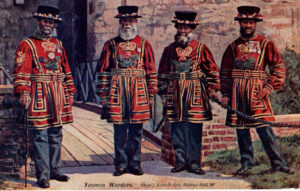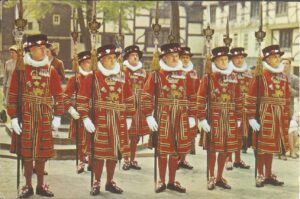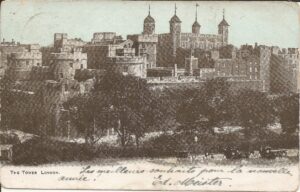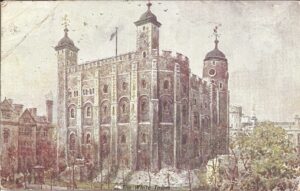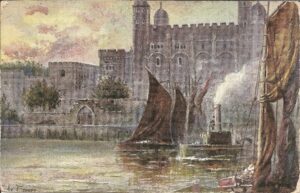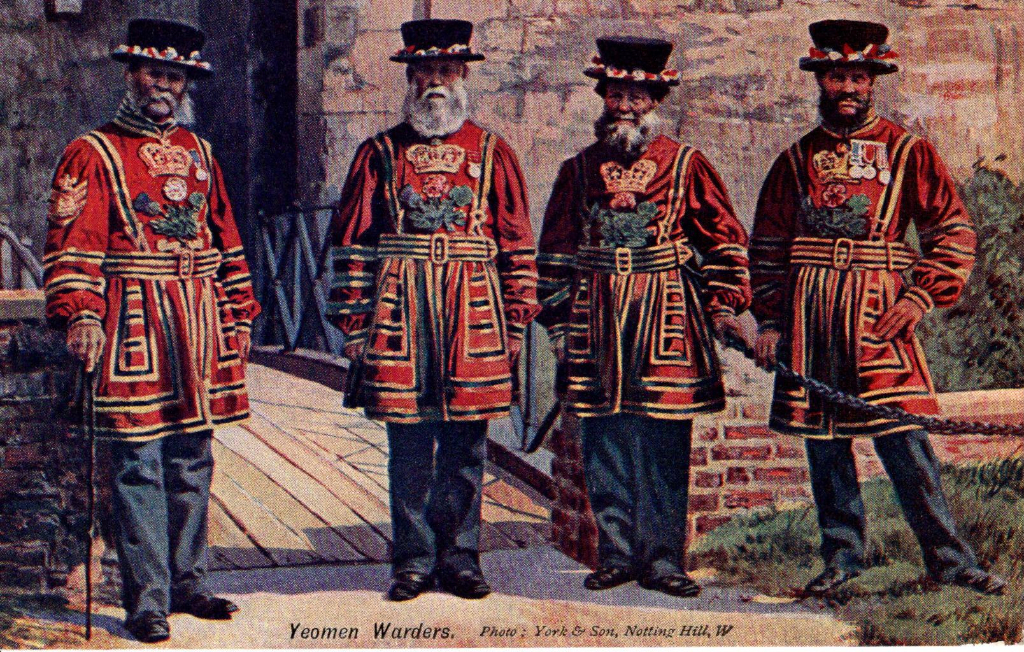
The 1870s Tower welcome. This is probably one of the earliest photographic images of Yeoman Warders that ended up in popular circulation – albeit 30 years later. Magnificently whiskered in the military fashion of the day and resplendent in full dress coats these ex-Army Warrant Officers had all seen active service and were well equipped to deal with unruly visitors. By the time of posting in 1905, Edward VII had replaced his mother Victoria on the throne, and the gentleman subjects passed. Recycling of images is common on Tower postcards no doubt under the mistaken idea that little changes and no one will notice.
Postcard Dated 4 JAN 1905
York and Sons’ original black and white photograph was taken between July 1870 and March1873 and first appeared as a lantern slide. Cassells colourized it as part of their Art Postcard Series in the early 1900s.
Today we expect smiling hosts. These gentlemen had a serious job to do and in 1870 posing for the camera was still a novelty – and dental care far inferior.
Tower tourism was changing, and the authorities, conscious of the stocks of weapons and military equipment stored on site, remained wary of the visiting public. Bowing to pressure, they introduced selected free days from 1875 (Mondays and Saturdays). Visitors were shepherded round a set route in groups under the watchful eye of a Yeoman Warder – and from Tuesdays to Fridays paid for the privilege. The site remained closed on a Sunday. In the background the architect John Taylor continued Anthony Salvin’s re-imagining and re-building dilapidated parts of the site.
The Body’s original role as guardians of state prisoners had largely become redundant, and they embraced custodianship of Tower history and lore with gusto and great showmanship. Sir Charles Yorke, Constable of the Tower, described their approach in 1880 as “toddle and twaddle”.
Twenty three “Yeoman Warder – Chelsea Pensioner” and their families called the Tower home according to the 1871 Census with Henry Hughes (60) recorded as ‘Chief Warder of the Tower’. The longest serving Yeoman Warder was Peter Ramage (74) who joined in 1840 and is described as Yeoman Porter in the 1851 Census return. Of the 23 men, 3 joined in the 1840s,8 in the 1850s, 12 in the 1860s and one in 1870. By the time of the 1881 Census, 9 had died and one resigned.
Frustratingly putting faces to names at this period is very difficult. The gentleman standing slightly apart from his fellows wears the White Tower on chevrons badge which today denotes the Yeoman Gaoler, second in command to the Chief Yeoman Warder. Unfortunately, titles are unclear at this time, and the Census remains silent on the subject. However, the same figure appears in James Davis Burton’s 1868 photograph of Yeoman Warders at the rear of the Byward Tower which suggests this might be YW Ramage. Ramage died in 1873, Thomas Bunyan succeeding him as Yeoman Porter. Confusingly, Bunyan does not appear in the Tower Census returns of 1861 or 1871*, despite joining the Body in 1859.
The same figure captioned “A Yeoman Warder” also features (duly credited) in D H Parry’s article The Tower and Its Traditions published in Cassell’s Magazine of June 1904 accompanied by H E Tidmarsh’s illustrations of Tower scenes. Cassell’s were relative latecomers to the post card publishing boom but subsequently turned Tidmarsh’s artwork into 2 sets of Tower postcards.
The 1901 Census records a Letitia Saunders (61), widow, living “on own means” at Lyndale, Walton on Thames – no mention of Kings Road – with her children Thomas (26) and Catherine [sic] (22), and 16-year-old general domestic servant, Gertrude G M Green. Born Letitia Northey in Devon in 1841, she married Richard Saunders, chemist and druggist, in the 1860s. Their four children were born between 1870 and 1879, and they lived in Plymouth. The 1891 Census shows widowed Letitia resident in Okehampton with Katherine, her youngest child, as does the 1911 return.
As to her mystery correspondents? Could ‘M.E.N’ be Mary Emily Nixon, Letitia’s Okehampton next-door neighbour in 1911?
*NB a number of pages are missing from the online version of the 1861 Tower return.
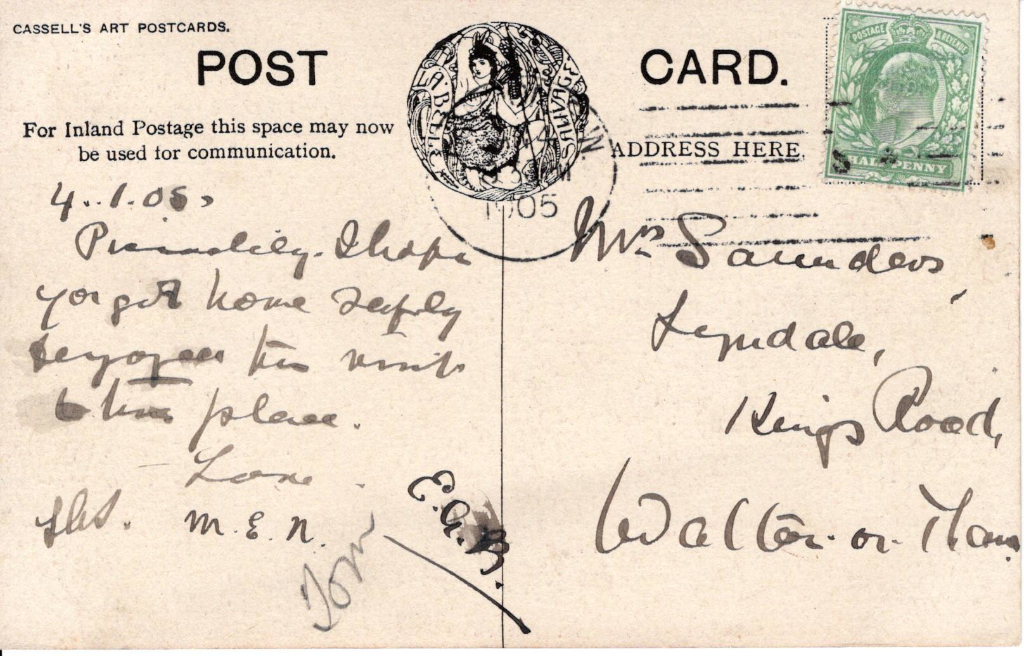
Recipient
Mrs Saunders, Lyndale, Kings Road, Walton on Thames
Transcript
4.1.05
Piccadily. I hope you got home safely & enjoyed the visit to this place. Love ….
Postmark
JAN 4 8.30 PM 1905

